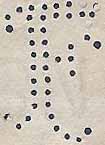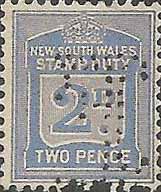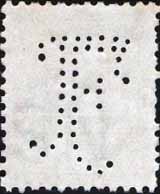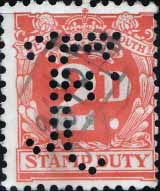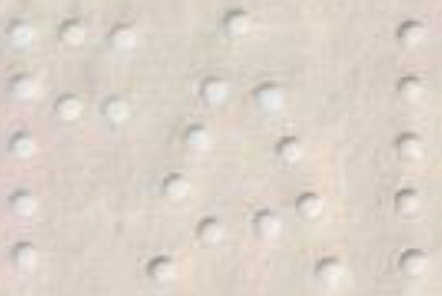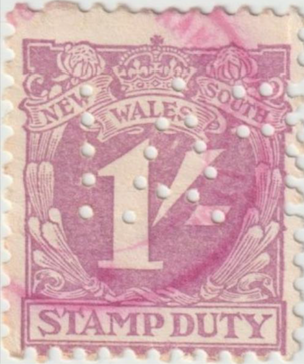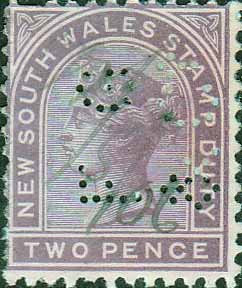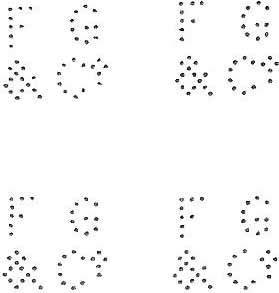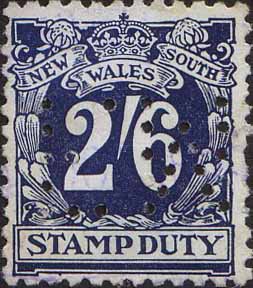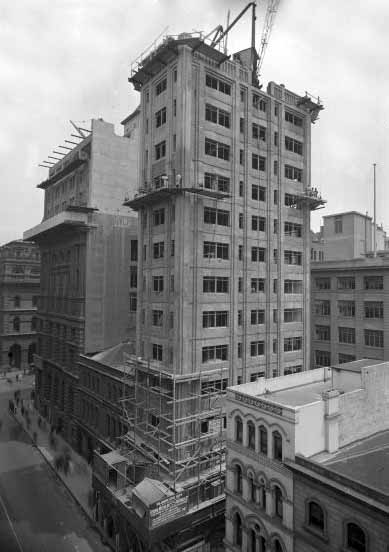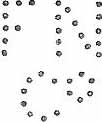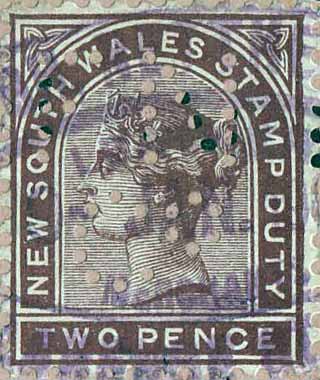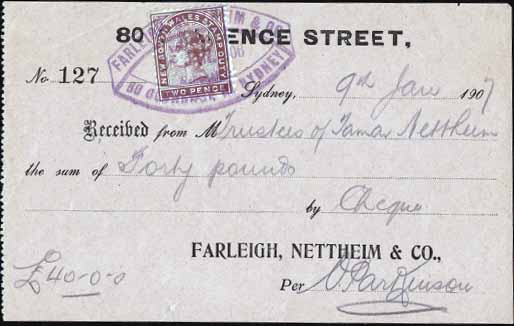|
Private Revenue Perfins of New South Wales An Elsmore Coath production The authors would welcome your comments additions or input into this work A B C D E F G H I J K L M N O P Q R S T U V W Y Other F -------------------------------------------------------- F.a .b
F.a F.b
F.a (repair) F.b (thick pins) User: Farmer & Co Ltd Wholesale and retail Draper and later Department Store Address: George St, Sydney, NSW Revenue Use: Numeral 1917-28 issue 2d Numeral 1929-66 issue 2d R4 Rarity Scale: Numeral 1917-28 issue 2d R3 Numeral 1929-66
issue 2d R4 Railway Use: Numeral 1918 R/NSW wmk issue 1/- Rarity Scale: Numeral 1918 R/NSW wmk issue 1/- R4 Background: *Joseph Farmer was born on 26 June 1814 in Halesowen, Worcestershire, England and came to Sydney with his wife Caroline as bounty immigrants on 31 March 1839. Bounty Immigration had been established in 1835 and provided assisted passage plus financial payment to suitable immigrants. Joseph was most likely sponsored by his elder brother Jonathon who was already in Sydney and had a Diary at Darlinghurst. In September 1839 Caroline opened a dressmaking and millinery shop, and in 1840 Joseph, opened a drapery named 'Victoria House' in Pitt Street. Later in 1843 Joseph moved his Pitt St location to a larger location near the corner of Market St. and next to Charles Appleton & Co, (David Jones former partner). Joseph later purchased this property and secured the title to the property on the other side of Appleton’s as well. In 1844 he opened a branch at Parramatta although this only operated until about 1852. In the late 1840’s the business was leased to a company of Price and Favenc (later Price, Favenc and Gwyn) but this was for only 5 years. In that time Joseph took his family back to England but he returned to NSW in 1849 where he commenced plans to secure the George St site that was to become Farmers landmark store. In 1850 Joseph again took the family to England not returning until 1853 and this time to Melbourne where he built the Bourke St premises of Buckley and Nunn for his friend Mars Buckley. Farmer had befriended Buckley and was instrumental in the choice of his partner Crumpton Nunn. Joseph rented the site to Buckley until 1872 when Buckley purchased it. In 1848 William (later 'Sir' born 1832) Farmer, Joseph’s nephew, arrived in Sydney and joined the business and in March 1854 he took over control of the company and it quickly grew to have almost 20 employees. William secured the lease on Appleton’s premises in 1854 and this gave the company a dominating frontage on Pitt St. William had a series of partners including William Williams, Francis Giles and later in 1860, Richard Painter, in 1865 John Pope and at this time the company was styled 'Farmer, Painter & Pope'. Painter retired in 1869 and the company became J. & W. Farmer & Pope and later Farmer & Co, although Pope retained his shareholdings and became the companies first Managing Director in 1897. In the 1870s Joseph returned to England and he died on 22 November 1890. Under William Farmer and Popes leadership the company became the first ‘department’ store in Sydney and by 1869 they had 26 different departments with both imported and locally manufactured goods. In the early 1860’s the company secured the 291-293 George St site and this with renovations to the Pitt St allowed customers to walk through the between George and Pitt St's. The Pitt St site was later demolished and in 1874 a new purpose built store was erected only to be replaced again in 1910. William Farmer also returned to England to live at Ascot Place, Berkshire but retained his involvement with the company. On 5 January 1897 Farmer & Co. became a public company (incorporated in London) with William Farmer (knighted in 1898) as Chairman (from London) until his death in 1908. John Pope then took over as Chairman and he brought his two sons into the company, he died in 1912. Farmer & Co. was a leading innovator in Australian retail trading being the first to departmentalise (1863) the first to have a Radio licence (1923-2FC for Farmer and Co) the first to install escalators (1927) and air conditioning (1936). Like fellow Department stores, David Jones and Anthony Hordern, Farmer & Co Ld published and distributed catalogues and conducted a vigorous mail order business for country customers. The company was acquired by the Myer Group in 1960 but continued to trade as Farmers. From 1976 it became Myer (Sydney). Device: F.a F.b
F.a F.b Device:
F.a and F.b are the two heads of a two head
horizontal device with F.1 on the left and F.2 on
the right. The pattern is a stylized F and is
without doubt one of the most stylish patterns
used on Australian Stamps. The two patterns are similar but they have small but distinct differences as follows:
F.a The centre cross bar intersects into the upright of the F directly in line with the pins of the upright
The top right hand edge of the F kicks up slightly
F.b The centre cross bar intersects into the upright of the F in between the pins of the upright
The top right hand edge of the F curls down slightly
The device came into use in the early 1920’s and is very common on postage stamps but it is very rare on revenue stamps. Most examples will be encountered on the 2 pence value from the 1917 series and we have seen only a single example on a 1929 Numeral series. Notably this was an F.a in the Thick Pins format indicating use in the later 1930’s.
The device started to deteriorate in the early 1930's particularly in the top left hand corner of both dies. Then in about 1932-34 the device was repaired and a slightly different pattern was formed. It is nearly impossible to detect any change in the F.a but it is more noticeable in the F.b pattern where the curl on the top left of the pattern has a few slightly different pin locations. This repair was not entirely successful and strikes after 1934 are characterised by a lot of missing pins.
In 1938 the dies seem to have been remade with thicker pins. These thicker pinned dies removed a fair bit of paper and because of the size of the pattern and the number of pins some holes tended to merge. This issue was exacerbated by the fact that the contemporary stamp issues were smaller than the earlier KGV issues. These thicker pinned strikes are not common as they appear towards the end of the life of the device.
There is some evidence to suggest that the die was modified again very late in its life and that some pins were removed. This produced an F shaped pattern with thicker holes but less pins consistently across the pattern. These patterns are also characterised by blind and poorly struck holes and are barely recognisable as the beautiful F‘s that were created by the device in its early days.
It is likely that the continued deterioration of the device along with the reduction in the size of postage stamps and the onset of WW2 all conspired to end the use of this iconic pattern. Related Patterns: Nil *Biography of Farmer https://adbonline.anu.edu.au/biogs/A040161b.htm
-------------------------------------------------------- FAI.a
User: Fire and All Risks Insurance Co Insurance Address: 34-36 King St, Sydney, NSW Revenue Use: Numeral 1929-66 issue 9d, 1/-, 8/-, 10/-, £1 Rarity Scale: Numeral 1929-66 issue 9d R4, 1/- R2, 8/- R4, 10/- R2, £1 R4 Background: *Larry Adler, full name: Lawrence James Adler, original name: Laszlo James Adler, was born 2 November 1931, in Budapest, Hungary of Jewish parents. Adler’s father died in a NAZI Concentration Camp and Larry left Hungary in 1949 arriving in Australia in 1950 as a refugee who had no money and knew no English. He
initially worked in Melbourne as railway labourer
but later as a cleaner and a taxi driver in
Sydney. Larry Adler’s life was detailed in his biography, “From Cabbie to Chairman”, by Peter Denton, published shortly after Larry’s death in December 1988. FAI opened for business in November 1960 and had a shaky start made worse by the Government imposed credit squeeze of 1960-61 which saw interest rates rise, credit restricted, and a higher sales tax imposed on cars, creating a slump in car insurance which was one of FIA’s target businesses. FAI was in trouble immediately and they were considered too risky, but they support by a small financier called “Direct Acceptance Corporation” whose own finances were like FAI’s. Later FAI gained some Workers Compensation business through Julius Charody, who had owned a taxi that Larry Adler had driven in his Cabby days. FAI began to grow, and they absorbed some small car insurance companies and expanded interstate but the “word” around Sydney was that the company was built on a poor base. Some of these comments could be attributed to prejudice as the Insurance business was heavily influenced by well-established British based firms and Larry Adler was not inclined to play by the established rules. One joke that circulated in the early days of FAI was that they were “an insurance company without a claims department”, but no Insurance company gets rich paying out claims and most insurance companies are rich with substantial funds under management. Here Larry Adler was again different and rather than keep his funds in secure investments he was aggressive and unorthodox risking large sums on speculative shares through Investment Companies started by Adler. This behaviour drew the attention of the “NSW Workers' Compensation Commission”, which began an inquiry into FAI in September 1971. This placed FAI’s Licence at risk, but the slow action of the Commission and Adler’s enthusiastic litigation managed to keep the matter in the courts and undecided until the early 1980’s. The case was ultimately decided by Justice Frank McGrath of the Compensation Court of NSW on 31 October, 1980, and he criticised FAI, its practices and its poor financial viability and recommended that the Licence be withdrawn. However, Adler announced he would appeal to the Privy Council and FAI was again able to continue in business pending the appeal. In the end it never eventuated. FAI continued to grow by acquisition, something common in the Insurance Industry but his crowning achievement was securing funds through the sale of its shares from the Mosbert Group that was investing in Australia and South East Asia with finance provided by the Moscow Narodny Bank. William
Farmer also returned to England to live at Ascot
Place, Berkshire but retained his involvement with
the company. But Adler ultimately miss judged and he lost heavily when the markets collapsed in 1987, loosing half of his capitalisation as it went from $2.1billion to $1 billion overnight. When Larry Adler died in December 1988, FAI was still unstable and the markets were not reassured when the Larry’s son, the untried, 29-year-old Rodney Adler took over. Photo of Rodney and Larry Adler in the 1980’s. Perhaps
Rodney Adler's greatest feat was that he kept FAI
“alive” from the death of his father until its
sale of the company to HIH in 1998. HIH paid $300
million for FAI and this included subsidiaries
such as FAI Life, Anaconda Nickel, One.Tel,
Financial Services company “Godfrey Pembroke” and
Oceanic Coal. Device: This was most likely a single head device. Related
Patterns: Nil *Australian Financial Review article by Trevor Sykes (8 June 2002), Britannica, Wikipedia, -------------------------------------------------------- FG/&Co..a
User: Feldheim Gotthelf Ltd General Merchants Address: Corner of Clarence and Barrack St's, Sydney, NSW Revenue Use: QV 1880-1902 issue 2d Rarity Scale: QV 1880-1902 issue 2d R4 Background: *Feldheim, Gotthelf & Co (some sources Gothelf) where general merchants in Sydney. The principal of the company was Moritz Gotthelf but the identity of his partner is not clear as the name Feldheim does not appear in lists of managers and executives. Feldheim may have been Isaac Feldheim of the Melbourne based company of Feldheim, Jacobs, and Co that operated in the 1860’s through until the end of the 1880’s. They were based in Melbourne but had branches in Sydney, Adelaide and Brisbane. Both Isaac Feldheim and Moritz Gotthelf were involved in the Anglo-Jewish Association which had its parent body in London. In ‘The London Gazette’ of 7 August 1885 there was the following announcement: “Notice is hereby given, that the Partnership heretofore subsisting between us the undersigned, Isaac Feldheim, Moritz Gotthelf, and William Gross, carrying on business as Merchants and Importers, at Bury-street, St. Mary Axe, in the city of London, and at Hunter-street, Sydney, in the Colony of New South Wales under the style or firm of Feldheim, Gotthelf, and Company, has been dissolved, by mutual consent, so far as concerns the said Isaac Feldheim, as from the 1st day of April, 1885; and that the said business will in future, be carried on under the same style by the said Moritz Gotthelf and William Gross, by whom all debts due to; and from the said late partnership will be received and paid respectively. Dated this 1 April, 1885. Isaac Feldheim. Wm. Gross. Moritz Gotthelf”. This announcement certainly confirms the name of Gotthelf’s partner as Isaac Feldheim but does not confirm that it is the same Isaac Feldheim of Feldheim, Jacobs, and Co, however given the timing and business interests it is a reasonable assumption. Moritz Gotthelf was born in London in 1841 and arrived in Sydney in 1860 and Feldheim, Gotthelf & Co commenced trading in around 1873, initially from premises at Moore St and Hosking Place as well as from warehouses in Circular Quay. The London Gazette announcement states that they were in Hunter St but they were certainly still in Moore St, at the time of the Pitt St fires of 1890 as this blaze led them to move to 97 York St, and they were later occupants of 143-145 York Street as well but by 1900 they were located at the corner of Clarence and Barrack St's. The company was styled as Feldheim, Gotthelf & Co., Merchants and General Importers of British, Continental and American Merchandise’.
The company was incorporated as Feldheim, Gotthelf Ltd on 23 September 1910 and the first directors were Moritz Gothelf (Managing Director), William Gross, Lewis E. Isaacs, and William Dixson. Moritz Gotthelf and his wife Sarah, left Australia in December 1911 due to Moritz’s poor health. Moritz died in 1926. In February 1924 following a few poor years trading the shareholders of the company decided to put it into voluntarily liquidation, however the company continued to trade as Feldheim, Gotthelf Ltd (In Liquidation) until at least 1927.
Card showing Clarence St premises Moritz and Sarah Gothelf Circa 1860s Device: The FG&CO.a device was a multi head device most likely in a 2 x 2 format as multiples show consistent separation between horizontal as well as vertical pairs of strikes.
The four (or more) heads of the device are essentially the same and they produce patterns that are nearly indistinguishable from each other. There are small variations in the shape of the top of the F’s and some of the spacing between the letters is very slightly different. Given that the dies cannot be easily distinguished we have considered it to be a single pattern.
The device was used by the company from at least 1895 until about 1920. It is quite common on postage stamps but revenue usage is very rare. Related Patterns: Nil *AusPostalHistory.com
*State Library of NSW
*Trove -------------------------------------------------------- F.M.a
User: Federal Mutual Insurance Co Insurance Provider Address: 129 Pitt St, Sydney, NSW Revenue Use: KEDVII 1909-28 issue 8d, 2/- Numeral 1917 issue 2d Numeral 1929-66 issue 3d, 4d, 6d, 8d, 9d, 1/-, 1/6, 2/-, 2/6, 3/-, 4/-, 5/-, 6/-, 8/-[brown], 8/-, 10/-, 12/-, 14/-, 18/-, £1, £5, £10 Decimal 1966 Rarity Scale: KEDVII 1909-28 issue 8d R4, 2/- R4 Numeral 1917 issue 2d R4 Numeral 1929-66 issue 3d R3, 4d R3, 6d R3, 8d R4, 9d R4, 1/- R2, 1/6 R3, 2/- R3, 2/6 R2, 3/- R2, 4/- R4, 5/- R2, 6/- R4, 8/-[brown] R4, 8/- R4, 10/- R2, 12/- R4, 14/- R4, 18/- R4, £1 R2, 30/- R4, £5 R4, £10 R4 Decimal 1966 Background: *The Federal Mutual Insurance Co. of Australia Ltd. was formed in 1912 and its head office was at 129 Pitt St, Sydney although the company did have branches in Melbourne, Brisbane and Adelaide. The company offered Fire, Marine and Accident cover and was established on the ‘mutual’ principle, which allowed share ownership in the company commensurate with the amount of insurance business that you placed with the company. In October 1927 they redeveloped their site at 129 Pitt St and built a 12-storey office building, which remains to this day. London Assurance acquired the company in September 1951 although they continued to trade in their own name. Device: This FM device was most likely a single head device. It is only found used on revenue stamps of NSW and its usage stretches from the 1920’s until at least 1964. Early usage prior to the 1930’s is rare.
There is another FM device and pattern that is found used on the postage stamps of NSW and those of the early Commonwealth period until 1914. This earlier FM devices was also located in Sydney but is unlikely to be associated with the user of FM.a as The Federal Mutual Insurance Company was not established in Sydney until 1912 and this other FM device is known to have been used in Sydney as early as 1908. Related patterns: Nil *Trove 129 Pitt St, Sydney, NSW Picture courtesy of National library of Australia -------------------------------------------------------- FN/Co.a
User: Farleigh Nettheim & Co Tanners and Boot Makers Address: 80 Clarence St, Sydney, NSW Revenue Use: QV 1880-1902 issue 2d Rarity Scale: QV 1880-1902 issue 2d R4 Background: *Farleigh Nettheim and Co was formed by Melbourne businessmen, Edwin Michaelis and Isaac Hallenstein, of Michaelis Hallenstein & Co who had settled in Melbourne 1864. Their they opened a business at 441-445 Lonsdale Street, as merchants of imported cotton drill, threads and leather, mainly for footwear production. Later they established a tannery on the banks of the Maribyrnong River in Footscray.
By the late 1870’s their businesses in Melbourne were flourishing so the partners decided to establish a similar group of businesses in Sydney. To do this they sent two of their employees, John Farleigh, (son of an English migrant), and Cosmann Nettheim, (nephew of Isaac Hallenstein), to start as importing merchants in Sydney, in a company to be called Farleigh Nettheim & Co.
Farleigh and Nettheim took premises at 80 Clarence St and in 1880 they established a tannery in Stanley Street, Concord on property that extended into Canada Bay. John Farleigh died in 1884 and was succeeded by his nephew, John Gibson Farleigh, who had joined the company in 1877 and his son Howard later joined him. Nettheim remained active in the business until his death in 1907 and at that time Ernest Baruch was sent from Melbourne to assist John Gibson Farleigh in the business. The company prospered and they opened a boot upper factory in Kent Street, Sydney and increased their production to meet the growing demand for leather from China. John Gibson Farleigh stayed in the company until his death in 1949 as well as serving in the New South Wales Legislative Council from July 1908 until April 1934. Baruch had died in 1947 and at that time Charles Dodds became Managing Director, having started in the company as a junior in 1909. In 1950 Howard Farleigh retired as Tannery Manager and shortly after the position was taken by Dodds’ son Colin who was an Industrial Chemist and had worked at Michaelis Hallenstein & Co for nine years at their Footscray Tannery. Colin implemented new tanning methods and increased production and on his fathers retirement in the early 1960’s he became Director and General Manager of Farleigh Nettheim & Co. In 1967 Farleigh Nettheim & Co. in conjunction with Michaelis Hallenstein & Co and related companies in Adelaide, Perth, Brisbane and Dunedin (NZ) collectively acquired J. Bayley & Sons, and in doing so became the largest tanning and footwear merchandising group in Australia. Device: The FN/Co.a device was most likely a single head device as it is found centrally struck on stamps of a range of sizes including smaller issues such as the postage stamps of NSW and also larger format stamps such as the Commonwealth commemorative issues of the 1930 and the Railway stamps of NSW.
The pattern is not found on revenue stamps but it is found Railway stamps of NSW.
Usage is from 1905 until at least 1938. Related patterns: Refer to Michaelis Hallenstein & Co patterns in: VIC: MH.a, MH/C.a. MH/CO.a, MH/CO.b *City of Canada Bay Heritage Society from and article by Colin S Dodds, (last General Manager of the Company) *Australian Dictionary of Biography -------------------------------------------------------- FR.a User: Unknown Background: Reported but not seen by the authors Device: This was most likely a single head device and it is very rare. The device was used in Sydney in 1916 and it has been reported on revenue stamps but the authors have not an example of this usage. The authors have not seen this pattern on either the revenue or railway stamps of NSW. Related Patterns: Nil -------------------------------------------------------- A B C D E F G H I J K L M N O P Q R S T U V W Y Other © copyright 2011 |
